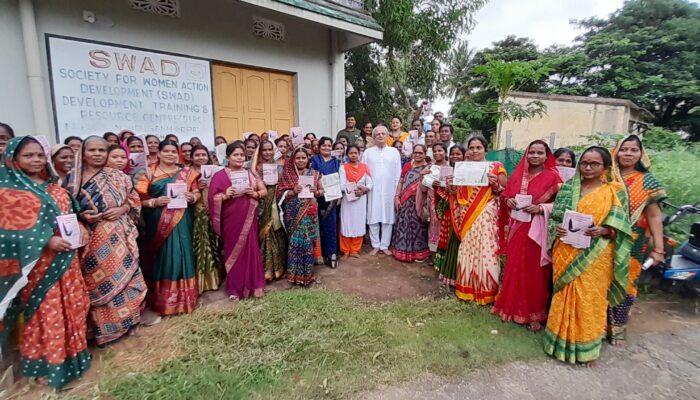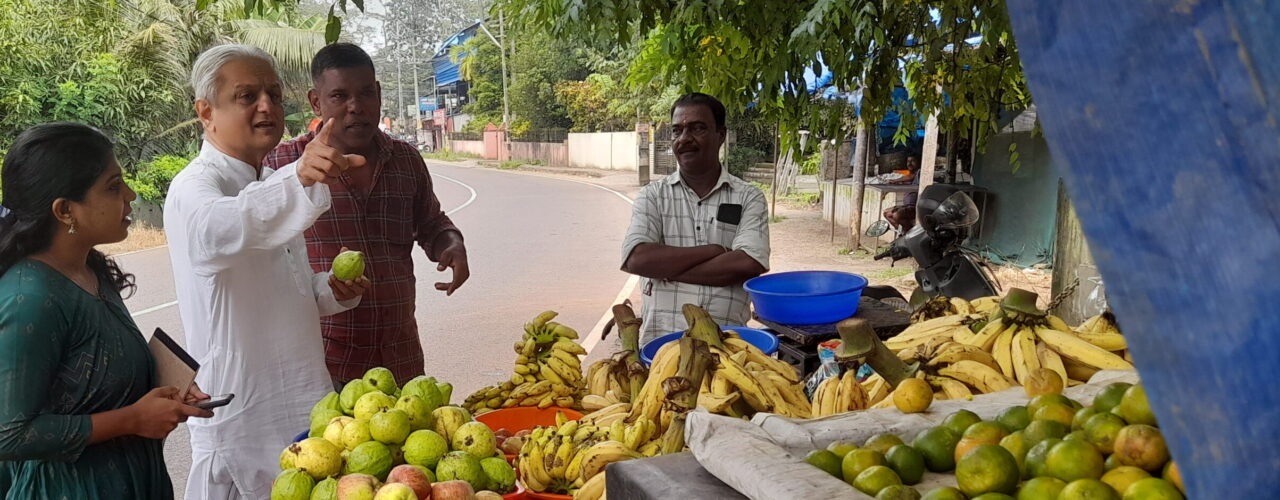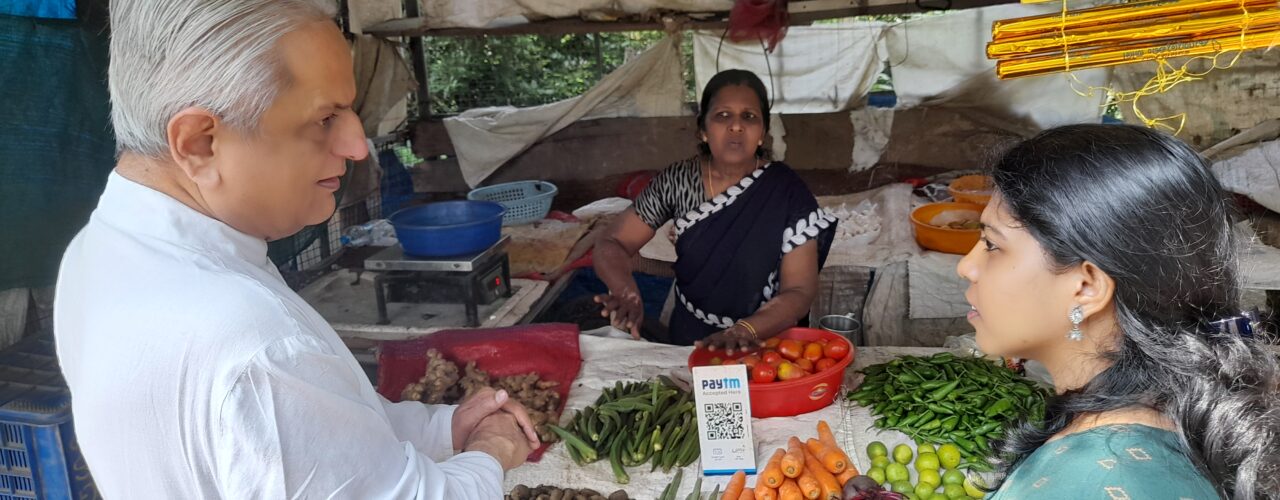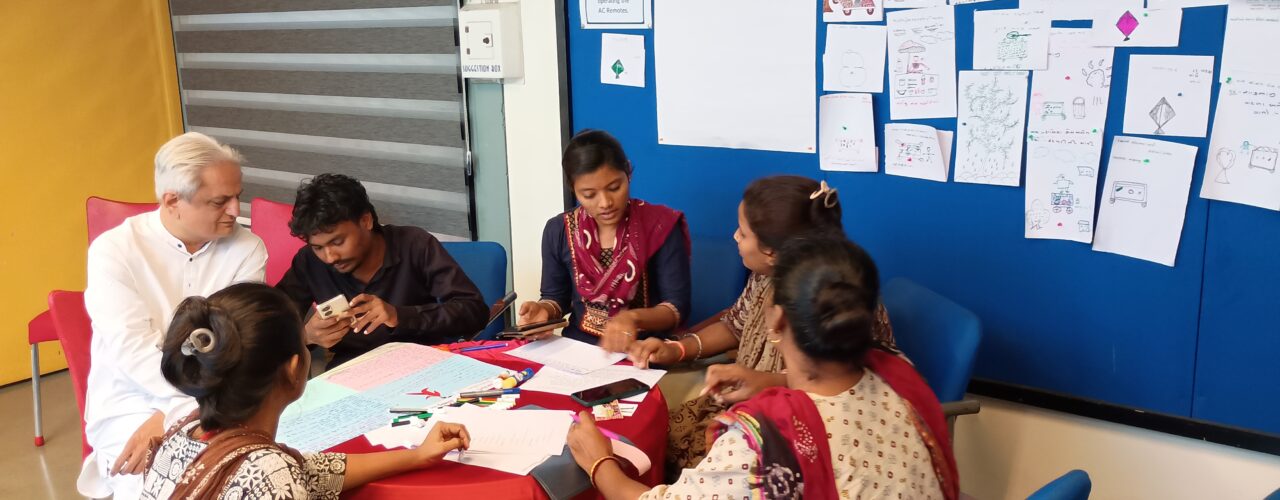Leveraging local capacity lies at the heart of our philosophy

Can you tell me something about yourself and the work that you're involved in?
Yes, of course! My name is Mihir, and I work for the All India Mitigation Institute (AIDMI). I also work with the Humanitarian Observatory Initiative – South Asia (HOISA). AIDMI is a local action-learning organisation that has been active since 1995. At AIDMI, our focus is on people affected by disasters as leaders, not just after disasters occur, but also before and in between. We aim to support the leadership of those likely to be affected, recognising that in many communities, the same people are hit again and again by different crises.
The key question we often ask is: What can people do between two disasters to reduce their risk and vulnerability? That window—after one event and before the next—is where we focus most of our work and learning alongside the communities we serve.
We engage with a diverse range of local stakeholders—including women, small-scale farmers, entrepreneurs, migrants, minority groups, and Indigenous and tribal communities. We adopt a bottom-up approach, keeping our work simple, direct, and grounded in the lived realities of those we serve.
Leveraging local capacity lies at the heart of our philosophy, as Mehul Pandya—who launched our first training and learning circles two decades ago—has long reminded us. Even in the aftermath of a disaster, individuals and communities possess an inherent strength that, when recognised and nurtured, can transform loss into new life. Our role is to observe, identify, support, and amplify that resilience so that, over time, affected people grow stronger in the face of recurring or cascading shocks. We’ve seen this principle in action throughout our work.

Can you give an example of how you engage with people before they are affected by a disaster?
Yes, absolutely. In fact, I can share something that happened just the day before yesterday.
In Ahmedabad, India, we convened a group of small business owners who are increasingly struck by extreme heat. This isn’t a one-off event—it will return next year, the year after, and only grow more intense.
To tap into their long-term perspective, we asked 25 heat-affected entrepreneurs:
“Can you imagine your life 20 years from now? What will you be doing, and what resources or support will you need—why, and from whom?”
That conversation was extraordinary. Rather than fixating on immediate survival, participants began to think long-term—mapping out not one but four distinct future scenarios. We so often undervalue the ability of affected communities to envision pathways out of crisis and plan for a distant tomorrow.
Here’s what I took away: even communities repeatedly hit by disasters can—and do—envision strategies that span decades, not just the next twelve months. Our role as humanitarian workers is to carve out space for those conversations and help translate long-term visions into actionable resilience plans. Now, working alongside these entrepreneurs, we’re co-designing a dedicated long-term financing mechanism to bolster their capacity to withstand and adapt to worsening extreme heat.
How do you operate?
Our approach begins with identifying critical gaps—urgent issues central to affected communities that other organisations or sectors haven’t adequately addressed. When the humanitarian system overlooks something vital, we see it as our signal to step in.
Another significant part of our work involves evaluations, and that’s where HOISA comes in. We conducted about 400 evaluations, most of them focused on local projects. Through this, I came to a key realisation: learning is important — but learning how we learn is just as important. Reflecting on humanitarian learning is crucial: who leaves, why, and how?

Learning is important – but learning how we learn is just as important.
We don’t let evaluations gather dust—using their outcomes is critical. For us, the utilisation of evaluation outcomes is critical. We use what we learn to inform the next set of action, including bringing people together in ways that challenge traditional timelines — like asking small business owners to imagine their future decades ahead, before the next disaster strikes.
That’s how the HOISA initiative was born. It isn’t just a response to extreme heat, it’s a dedicated space where learning, imagining, and preparation happen well before the next crisis.
What do you do with the outcomes of the evaluations?
Local and global organisations often commission us to evaluate their projects. We carry out the assessment, analyse the findings, and provide recommendations—that’s the standard approach. But over time, we’ve noticed something important: if you evaluate every project using the same framework, you often end up with similar findings, important that they may be, but that limits learning and therefore change.
The most valuable evaluations begin with observing and engaging a project before any formal assessment. This early immersion uncovers fresh insights, challenges assumptions, and often sparks new directions for action. Observing differently turns evaluation into a far more dynamic and exciting learning process.
At HOISA, we go a step further. We examine a project’s objectives independently and carefully select observation tools and methods that will provide the most meaningful insights. We avoid a one-size-fits-all approach — instead, we craft evaluations that are context-specific, reflective, actionable, and driven by observations. Roundtable is one good way to observe the same facts and views from many points of view. Thus, HOISA gives context of the context of evaluations by simply observing differently.
Ultimately, we’re not content with merely reporting results. We leverage evaluation as a catalyst for deep learning and informed decision-making, striving not just to reset but to transform systems into fair, just frameworks that deliver peace beyond conflict and pave the way for lasting prosperity.
Are the people who join your events at HOISA mostly from India?
Our events at HOISA are open to everyone, but yes—the majority of participants tend to be from India, simply because most of our grassroots work is based here and there are so many humanitarian organisations working in and on India. That said, we’ve also had international participants, and some truly meaningful cross-border collaborations have emerged, especially through our HOISA roundtables on the future of heatwaves, decolonizing funding, reparations for environmental loss, and humanitarian justice insights since 2023. It’s always encouraging to see ideas and experiences shared across and between countries in South Asia.

How did you get in touch with the humanitarian observatories in the Netherlands?
It was quite an organic connection. I’ve known Thea Hilhorst for a long time for her work and ideas and leadership even before she began finishing her PhD. A mutual Dutch colleague and I had collaborated on several evaluations, and through those experiences, we began exchanging reflections on both what we observed and what remained unseen during our field visits.
Over time, I contributed to a few joint publications, and when Thea and her team began developing the concept of the Humanitarian Observatory, I was part of those early conversations—rich with both personal insight and political nuance.
HOISA thrives on the “work” in network. The outputs, sessions, themes, and panels each carry their own momentum. Every Roundtable delivers so much, so well, that tracking the impact—and even the ripple effects of that impact—can be a challenge in itself.
How does being part of an observatory help you?
It’s a truly reciprocal relationship — we benefit from the observatory, and we also actively contribute to this expanding network of humanitarian observatories.
For AIDMI, the idea behind a humanitarian observatory is to create a space for deeper inquiry — a place to explore issues that demand careful observation, open reflection, and, at times, fresh perspectives. This spirit is embodied in the South Asia-wide Roundtable, which offers a rare opportunity to pause, notice, and learn in ways that traditional project cycles, networks, or alliances often don’t allow.
Through HOISA, we bring decades of experience, robust networks, established structures, and practical tools to support the observatory’s evolving efforts. Each topic naturally leads to the next; each panelist opens the door to new voices; each participant invites further participation. The process is dynamic, pluralistic, informal, and deeply organic.
It’s a mutually enriching exchange — we gain valuable insights while contributing grounded, practice-based knowledge in return.

What concerns you most about the current state of humanitarian action?
What worries me is the speed and scale at which humanitarian crises are emerging and refusing to be resolved. They’re happening faster, more frequently, and across wider geographies than ever before. Yet, the humanitarian response is not keeping pace. That gap is growing rapidly. I also worry about increasing separation between peace and humanitarian action. There cannot be any humanitarian action that does not lead to peace. And there cannot be any peace that does not reduce the need for humanitarian action, I have come to believe.
What concerns me deeply is our failure to question the social, economic, and political forces that pull us away from humane values and ethical action. You cannot build an economy that grows relentlessly and ruthlessly—disregarding the costs to labor, nature, and society—and then expect it to fund humanitarian aid as a remedy. That kind of humanitarian action becomes a contradiction. In the end, it simply doesn’t work.
I’m increasingly concerned that, as a civilization, we fail to interrogate the foundations of our systems — focusing instead on symptoms. And because we don’t, we continue to generate crises faster than we can respond to them.
I worry that we’ve lost faith in reflection as the necessary starting point. Real learning begins when we take the time to observe, to acknowledge what has happened — the successes, the failures, the blind spots. When we engage in honest recognition rooted in our own observations, those experiences gain meaning. That’s when transformation becomes possible.
Over the years, I’ve come to see the power of observation as truly profound. It’s not just a method — it’s a mindset, and a form of ethical engagement.
Too often, we rush ahead without fully understanding what could have been done differently. But when we name something — when we truly acknowledge it — it becomes something we can learn from, carry forward, and build upon.
Reflection born from observation isn’t just useful; it’s foundational. It’s what grounds humanitarian action in justice, humanity, and effectiveness. Without it, we risk repeating patterns instead of reshaping them.
What are the challenges in your work?
Or, may we call them opportunities?
One major opportunity is the institution itself. We us HOISA are still a small set up and we need to grow — not just in size, but in the depth and scale of our impact. We strive to achieve this with new and imaginative ways that affected people suggest.
The second opportunity is to realise the rapidly changing context in which we as HOISA operate. The planet is polluting. Economies are shaped by tariff wars. Social dynamics are evolving in unpredictable ways. Peace has become a matter of making a deal. It is in the middle of all this we must find our purpose and hope.
For instance, in India, before COVID-19, I was told that there were around 170 billionaires. After COVID, that number rose to 258 — all in just two and a half to three years. It’s astonishing to find that a historic humanitarian crisis led to millionaires become billionaires.
So it makes me wonder — with such vast wealth accumulation, why can’t we find an opportunity to ensure a few thousand people are adequately protected and cared for? This disparity underscores the broader humanitarian systemic challenges we face. Humanitarian action must reduce disparity and the reasons for that disparity to continue and grow, I believe.
You mentioned funding several times. Where does your funding come from?
Currently, we receive support from several sources. These include grants and calls from UN agencies and other international organisations. We also offer services such as training, planning exercises, and capacity-building on a demand basis to local to national organisations on a charity basis.
Additionally, our community contributes financially, demonstrating strong local ownership. We don’t yet have a formal revenue model, but we are exploring options — such as expanding training programs, developing applications, or offering new services — to help generate sustainable income. It’s a work in progress, but we are committed to sustaining and growing our impact. Those who want new, innovative, forward-looking humanitarian actions and thinking come to us, and we welcome that.
How do you see the importance of platforms like the humanitarian observatories?
I see their importance on multiple levels — conceptual, operational, and experiential.
We’ve become so accustomed to observing things in the same way that we forget alternative ways even exist. Observatories help us challenge our habitual ways of seeing, gather new perspectives, and deepen our understanding of both humanitarian action and humanitarian thinking.
The observatories also allow us to view our projects from different angles — to step back, reframe, and reimagine the work in fresh, original, or multiple ways.
On the ground, this reflection has real value. For example, we’ve used these platforms to help people affected by disasters think about their long-term future — not just the immediate crisis. Observatories help create the space for that kind of deep, strategic thinking, which is essential for lasting impact. I think that this multiple, plural, bottom-up, and cooperative way of observing action is most needed in transforming our humanitarian system today.
What is your dream for the future?
I believe we need more honest and deeper reflection. As humanitarian organisations, I think we’ve failed in some fundamental ways.
Just look at what’s happening in Ukraine, in Gaza, with the Rohingya. I’m not speaking politically — just humanly. The scale of inhumanity, the number of people being killed — it should make us all stop and ask: What are we really doing? How did we allow this? Who are we? Where did we come to this spot in humanitarian history?
Even the fact that an agency as large as USAID could be dismantled by a single signature — and no one individual or the entire system could stop it — is alarming. What has happened to international humanitarian law? Where is the collective will to uphold it?
So my dream is simple, yet difficult: that the global humanitarian community finds the courage to ask these hard questions with humility. That we create not just spaces for action by and with affected population, but also for accountability, reflection, and moral clarity. That we move from reacting to crises toward preventing them and in the long run reducing the reasons and forces that cause them to occur again and again— we do this with empathy, justice, and integrity at the core.
The humanitarian system must bring about fundamental and profound transformation in our economy and politics in the near future. The humanitarian system must be utopian in the best sense. It must re-define a radically alternative futures—yes many futures—and demonstrate while responding to each crisis, that it could be constructed for and with the affected people.
This program is part of the Humanitarian Observatories.
The Humanitarian Observatories are part of the ‘Humanitarian Observatories: Building a Knowledge and Advocacy Network on Humanitarian Governance’ project from February 2025-July 2026. This project has received funding from the European Union under the Horizon ERC Proof of Concept.
Views and opinions expressed are however those of the author(s) only and do not necessarily reflect those of the European Union or European Research Council Executive Agency (ERCEA). Neither the European Union nor the granting authority can be held responsible for them.
Date: 25th of July 2025
Author: Marianne van Elst-Sijtsma
